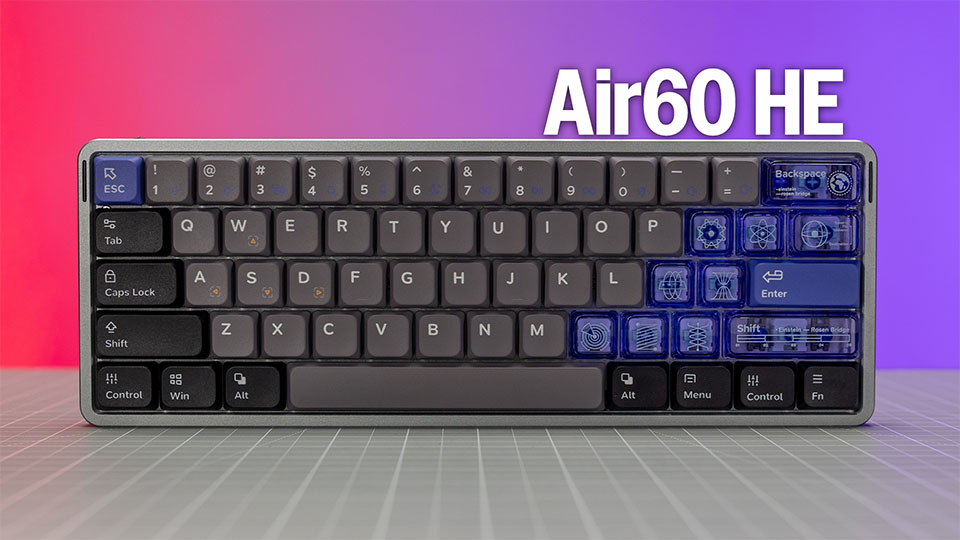Links in this post may be affiliate links. Any products purchased through affiliate links may provide a small commission which helps to support the SemiPro Tech+Gear site and YouTube channel.
NuPhy’s Field75 HE was their first hall effect keyboard and it packed a punch of gaming performance with sub-1ms latency and excellent customization options. Now NuPhy is back with one of the first low-profile HE keyboards on the market, with the all-new Gateron low profile Jade Pro HE switch and a blistering claimed latency of 0.1ms. But aside from the gaming performance, how does it handle daily productivity work?
The Air60 HE is unique among NuPhy’s other keyboards for more than one reason, the most visibly obvious being the traditional 60% layout. NuPhy previously did not have this layout in their lineup, with the regular mechanical Air60 (V1 and V2) being a modified layout that shrinks the right shift key in favor of arrow keys and a delete key – it’s sort of like taking a 65% layout and squishing it. By default, this means two things: fans of a traditional 60% layout will rejoice, and everyone else will not.
NuPhy Air60 HE
MSRP: $119.95 ($139.95 with Jade Pro switches)
Pros
- Excellent raw gaming performance (sub-1ms latency)
- Super-customizable functions including dynamic keystrokes
- Three customizable on-board modes/profiles
- Simple to use customization software
- Satisfying sound
Cons
- 60% layout won’t be for everyone
- Backlight shining through keycaps is a bit distracting
- Firmware updates can be a little confusing (calibration needed)
Best For: When you want elite gaming performance in a compact & low-profile design
Use code SEMIPRO for $10 off $100+ at NuPhy!
Features and Specifications
The Air60 HE has some fairly advanced customization features, but first let’s review the physical characteristics.
Construction & Design
The case construction includes an aluminum top frame and ABS plastic bottom. It’s nearly the same case as the regular Air60 V2, albeit with a different color scheme and a few minor differences. It looks and feels nice, certainly not cheap but also not super upscale. There are fold-out feet for two additional typing angles.
The internals include sound damping in the form of foam and silicone, which does a nice job of preventing any hollow sounds, but don’t expect a soft typing feel here. To maximize the accuracy of measuring switch actuation, NuPhy went with firm materials here as they did with the Field75 HE. However I actually don’t find the Air60 HE to feel as generic & stiff as the Field75.
The USB-C port is on the left side of the case, not the back, so you either need to use the provided USB cable or a right-angle adapter in order to avoid an awkward angle for your cable. The physical design of the case is relatively straightforward and there’s nothing really controversial here – at least not until we get to the keycaps (see that section below).
Ultimately the main point of contention in this category is the layout – as I mentioned above, a traditional 60% layout won’t be everyone’s favorite when it comes to daily productivity. I personally find that a 65% layout is my minimum for daily work, which for me includes a lot of general writing and some work with spreadsheets. The Air60 HE lacks any nav keys (DEL/HOME/END/PGUP/PGDN), arrow keys, and function-row keys. I can live without the function row, but not the arrow keys or nav keys. Repeated small annoyances add up for me with this layout, for example, the lack of a DEL key adds frustration when unlocking a Windows computer via the CTRL+ALT+DEL command (having macros available now does alleviate this a little bit). If you intend this to be a gaming-only keyboard or if you’re used to this layout, this will be a non-issue.
Connectivity & Performance
Connectivity is USB-C wired only. There are no wireless connections available, however that’s not uncommon for HE keyboards. There currently are not many wireless HE keyboards on the market (the Keychron Q1 HE is one), and sticking with a wired connection ensures you get the maximum 8k polling rate with no interruptions.
So how does the Air60 HE acheieve a latency of 0.1ms, lower than the Field75 HE’s 0.5ms? In addition to the 8k polling rate, the PCB scan rate is 8,000Hz rather than the 2,500Hz of the Field5 HE. The polling rate and PCB scan rate work in tandem as part of the communication signal chain. The PCB of the keyboard is continuously scanned to identify inputs (an internal process), while the polling rate is the frequency of sending “reports” to the computer. So first the keyboard has to detect the input, and then it can send it to the computer. Even with the same 8k polling rate, a keyboard with a higher PCB scan rate should have a lower overall latency because it’s identifying the inputs quicker.
If that was confusing, think of it this way – you and friend #1 are counting candies in a jar, and reporting the number to friend #2. You are counting the candies as you take them out of the jar, and friend #1 is sending that count to friend #2. You are counting one candy every two seconds, but friend #1 is sending a report to friend #2 every one second. So friend #1 is able to send the count faster than you’re able to count. This is what it’s like when you have a faster polling rate than the PCB scan rate. In order to get the lowest total latency possible, the PCB scan rate has to match the polling rate.
There has not been an independent test confirming the latency of the Air60 HE at the time of this writing – so far only the Field75 HE has been tested by rtings.com with a single-key result of 0.8ms, just 0.3ms slower than NuPhy’s stated figure. If we assume a similar result for the Air60 HE, it would put the figure around 0.3-0.4ms.
The bottom line for the Air60 HE is that the gaming performance is fantastic and it’s good enough for elite gaming.
Backlighting
The backlighting is per-key RGB and is south-facing, and there are side marker LEDs as well which communicate things like caps-lock status. The modes can be controlled with key commands or in the customization software, and overall I have no complaints about the backlighting. I do, however, have a complaint about the keycaps and how they interact with the backlight.
Switch Options & Keycaps
NuPhy offers two low-profile magnetic switches from Gateron. At the base MSRP of $119.95 we have Gateron Jade switches, and for the higher price of $139.95 you can opt for Gateron Jade Pro switches. The Jade Pro has a stiffer feel with 40g initial force and 60g bottom-out. They both offer 3.3mm of total travel, which actually is the same amount of travel in Gateron’s regular profile Jade HE switches. Some users may be looking for shorter travel since this is a low-profile keyboard, however the actuation point of the switches can easily be customized. If you want your required travel to be 1mm for actuation, that’s as simple as moving a slider in the software.
The keycaps are unique to the Air60 HE – meaning they’re not the same as the regular Air60 V2. They are low profile of course, but they are a mixture of solid color and transparent keycaps (NuPhy provides extra solid keycaps in the box if you don’t like the purple transparent version). My issue with these keycaps is that even the solid color ones are semi-translucent, allowing the backlight to shine through them. I do not mean the light shines through the legends – these are not traditional “shine-through” keycaps. It shines through the solid color of the keycap, which does nothing to help you see the legends in low light. It’s also distracting for me personally, especially because several of the keycaps have smaller sub-legends to indicate functions, especially in the number row, and this gives the keycaps a busy appearance with the lighting on. This is subjective and you may feel differently, but I don’t really get what NuPhy was going for here. The appearance of the keycaps with the lighting off is fine.
NuPhy also offers a set of low profile shine-through keycaps (all black) for purchase separately. The legends are huge and won’t be everyone’s cup of tea, but if you like the look, they do work more in harmony with the backlight.
Customization
NuPhy introduced their web-app, NuPhy.io, with the Field75 HE and it now also serves the Air60 HE. It supports windows, mac, and linux, and I far prefer using a web-based tool because I can access it on any machine the keyboard is connected to and don’t have to install any software that requires future updates.
There are three on-board profiles that can be customized and you can swap between the modes with the switch on the back of the case. By default the profiles are set up as windows, mac, and gaming modes, but all of them can be fully customized and you can even re-name the modes. From here, I’ll give the same overview of the options in NuPhy.io as I did in my Field75 HE article:
Customization options include traditional remapping of a few layers within each mode and adjusting the backlight settings. And then comes the HE customization – this is where things may get a little overwhelming to a hall-effect newbie, even from a terminology standpoint. The first adjustment to pay attention to is the actuation point, which determines how far you have to press a key before it triggers an input. By default they are set in the middle of the switch travel, which is fine for everyday use. Setting it lower means you have to use more force, which can be fatiguing over long periods. Setting it very high up can be better for gaming, but will lead to more mistakes when responding to those emails because even the slightest graze of a key registers an input. This is where different profiles come in handy – you can customize one for gaming and one for general typing.
Next to your actuation point setting is the option for rapid trigger and setting the reset point. The reset point determines how far the switch needs to return/rebound before another entry will register on the same key. Gamers generally like to have the same actuation & reset point because it means rapid-fire entries all register properly, vs. having a reset point that’s higher up than the actuation point which means you can’t repeatedly press the same key as quickly. Feeling overwhelmed yet? I hope not because we’ve only scratched the surface.
I won’t go into granular detail about all of the customization options here or this article will be longer than a Tolkien novel. There are multiple other options to customize your inputs, including dynamic keystrokes which allows you to set multiple entries for a single key based on the travel distance – basically you can have a string of entries occur in succession at different actuation points. There are also rapid-shift and SOCD options, and these are getting into how your keyboard behaves when multiple keys are pressed in rapid succession or at the same time.
One additional feature that’s been added since I reviewed the Field75 HE is the ability to create macros and assign them to keys. This is an important feature for a custom keyboard and it’s a welcome addition to NuPhy.io. There are keymap layers within each profile, allowing you to place macros in the function layer as desired.
Is it Worth It?
So, is the Air60 HE worth trying out? To me it depends on your use case and level of comfort with the 60% layout. If you know you just don’t want to live without arrow keys or nav keys, then this wouldn’t be a good fit. But if you’re ok with the layout and want great gaming performance in a low-profile case, the Air60 HE is an excellent option with top-tier performance and customization.
Check out the Air60 HE
Keyboard Specs:
Price: $119.95 (Gateron LP Jade switches) / $139.95 (Gateron LP Jade Pro switches)
Layout: ANSI 60% | 61 keys
Switch Options: Gateron LP Jade, Gateron LP Jade Pro
Hot-swappable: Yes (HE switches only)
Connectivity: Wired only (8,000Hz)
OS Compatibility: mac/windows/linux
Typing angle: 3.1º/ 7.0º / 10.0º
Frame: Aluminum
Bottom case: ABS
Keycap: PBT, nSA profile
Dimensions: 297.2 mm x 107.2 mm
Front Height: 13.2 mm
Rear Height: 18.8 mm
Weight: 534 grams (1.18 pound)


